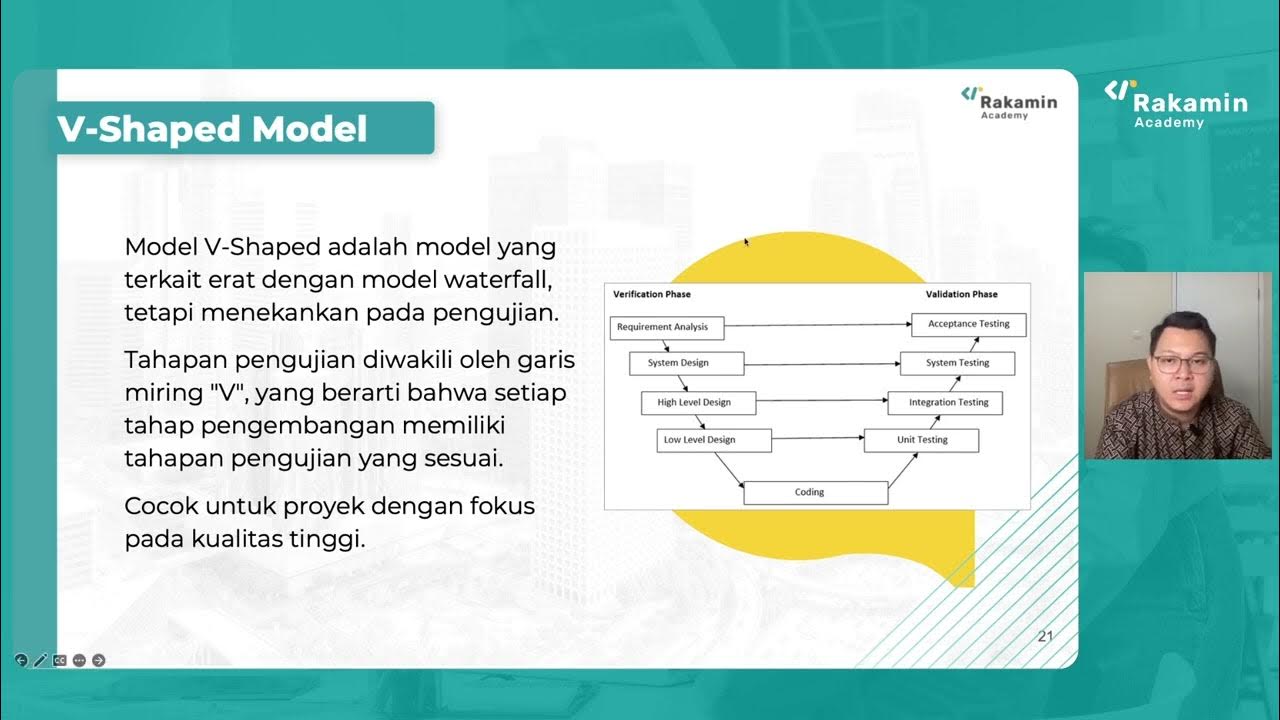Software Testing Tutorial #10 - Iterative Model in Software Engineering
Summary
TLDRThis tutorial explains the iterative development model in software testing, comparing it with the waterfall and V-model. It highlights the drawbacks of traditional models, like long delivery times, and introduces the iterative approach where development phases repeat in shorter cycles (4-8 weeks), allowing for quicker releases and better customer feedback. The tutorial provides a practical example of building an e-commerce application in phases, explaining how features are added incrementally. It also differentiates iterative development from Agile, noting that Agile is more comprehensive while following a similar cycle.
Takeaways
- 😀 The iterative development model was introduced to address the long delivery times in traditional models like the waterfall and V-model.
- 🚀 In the iterative model, the development cycle (requirements, design, development, testing, deployment) is repeated in shorter iterations, typically lasting 4-8 weeks.
- ⏳ Unlike the waterfall model, which could take up to two years, the iterative model allows for quicker delivery of working software.
- 🛠 Each iteration includes the same phases: requirements, design, development, testing, and deployment, but focuses on delivering small, incremental updates.
- 🔄 New features and enhancements are added incrementally in each iteration, improving the software progressively over time.
- 💡 An example of iterative development is building an e-commerce app, where the login page is created in the first iteration, and additional features like password recovery are added in later iterations.
- ⏱ While the iterative model shortens delivery time, it still follows a phased approach similar to waterfall, where requirements must be frozen before development starts.
- 📉 The iterative model improves feedback loops, as each iteration delivers a working product, allowing for faster feedback from customers.
- 💻 Agile and Scrum also follow an iterative approach with sprints, but agile introduces a broader mindset and values beyond just the development cycles.
- 🤔 Agile addresses more of the limitations found in waterfall, V-model, and iterative development, offering a more dynamic approach to software development.
Q & A
What is the main purpose of the iterative development model?
-The iterative development model was introduced to address the issues of delayed software delivery found in the waterfall and V-models. It enables faster value delivery to customers by allowing for shorter cycles of development and repeated iterations.
What are the key differences between the V-model and iterative development model?
-While both the V-model and iterative development model involve testing at each phase, the key difference is that the V-model still results in long delivery cycles, while the iterative model reduces the delivery time by repeating phases in shorter cycles of 4-8 weeks.
Why is the waterfall model considered inefficient for modern software development?
-The waterfall model requires a long time to deliver software, sometimes up to two years, which is not suitable for today's dynamic market conditions where faster value delivery is crucial. This is why iterative models were introduced.
How does the iterative development model handle requirements compared to the waterfall model?
-In the iterative development model, requirements are broken down into smaller phases and are continuously revisited with each iteration. This contrasts with the waterfall model, where requirements are gathered all at once at the beginning of the project and remain static.
What happens during each phase of the iterative development model?
-Each phase in the iterative development model follows a cycle of requirement gathering, design, development, testing, and deployment. This cycle repeats with each iteration until all requirements are fully implemented.
What are some examples of features that might be added during iterative phases?
-In an example of building an e-commerce application, the first iteration might include a login page with basic fields, and later iterations might add features like password recovery, social media login options, or improved design elements.
What are the main advantages of the iterative development model?
-The primary advantages are faster feedback and quicker delivery of working software to the customer, allowing for faster validation and adjustments based on feedback.
What is the major disadvantage of the iterative development model?
-Despite shorter cycles, the iterative development model still follows a phased approach where requirements, design, development, and testing are done sequentially within each cycle, which can lead to delays if requirements need frequent revisions.
Is agile development the same as the iterative development model?
-No, agile development is not the same as the iterative development model, though they share similarities in using short cycles. Agile goes beyond the iterative model by promoting a more flexible, customer-centric approach and continuous improvement, while iterative still follows a phased structure.
How does iterative development improve feedback loops?
-In iterative development, shorter cycles allow for quicker feedback from customers after each iteration. This feedback can be incorporated into future iterations, leading to continuous improvement of the product.
Outlines

Cette section est réservée aux utilisateurs payants. Améliorez votre compte pour accéder à cette section.
Améliorer maintenantMindmap

Cette section est réservée aux utilisateurs payants. Améliorez votre compte pour accéder à cette section.
Améliorer maintenantKeywords

Cette section est réservée aux utilisateurs payants. Améliorez votre compte pour accéder à cette section.
Améliorer maintenantHighlights

Cette section est réservée aux utilisateurs payants. Améliorez votre compte pour accéder à cette section.
Améliorer maintenantTranscripts

Cette section est réservée aux utilisateurs payants. Améliorez votre compte pour accéder à cette section.
Améliorer maintenantVoir Plus de Vidéos Connexes
5.0 / 5 (0 votes)






